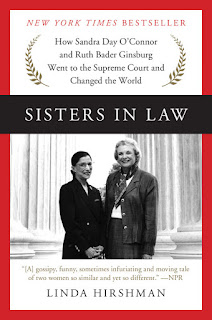This post is tribute to Ruth Bader Ginsburg and is review of the book 'Sisters In Law' by by Linda R. Hirshmandual.
After graduating from Cornell, she enrolled at Harvard Law School. In the class, there were only 9 women and about 500 men. The Dean invited the female law students to a dinner and asked them, why were they at Harvard, taking place of the males students. Later, she moved to Columbia, when her husband took a job in New York City. She earned her law degree in 1959, tying for the first place in the class. Despite this, her legal career did not start smoothly.
The very next year, Justice Felix Frankfurter rejected her for clerkship due to her gender, despite the strong recommendations of her teachers. Ultimately, she got clerkship with US District Court for the Southern District of New York, only when her Columbia law professor threatened the judge, never to recommend another Columbia student, if he did not give Ginsburg the opportunity. He also guaranteed the judge with a replacement, if she was not upto the mark. Ginsburg not only proved herself but completed her two year term. Thereafter, she went back to academia.
During 1961-63, Ginsburg was a research associate and then an associate Director at Columbia. In 1963, she became professor at Rutgers. But she was paid less than her male colleagues as her husband had a well-paid job. She shifted to Columbia in 1972, where she became the first tenured woman faculty member. She continued there, till she became judge of the United States Court of Appeals in 1980.
 |
| AddRuth Bader Ginsburg in 1972, when she became first tenured women faculty member of Columbia Law School - Picture from the book 'Sisters In Law'. |
While, Ginsburg was at Columbia, she was also actively raising her voice against women discrimination. She co-founded the Women's Rights Project at the American Civil Liberties Union (ACLU), and became its general counsel: participating and arguing gender discrimination cases. She challenged the discriminatory laws step by step, building on each successive victory. When she made her first oral argument in the US Supreme court, Geoffrey Stone, the constitutional scholar and clerk to Justice William Brennan called her, “the most important woman lawyer in the history of the Republic.”
She was appointed as a judge of the US Supreme Court on August 10, 1993. She held her office, till her death on September 18, 2020.
On her wedding day, Ruth Bader Ginsburg was advised by her mother-in-law,
“In every good marriage, it helps sometimes to be little deaf.”
She followed it at home. Her marriage was successful. When she was nominated to US Supreme Court, then Rom Clain, Associate White House counsel, said,
“Ruth Bader Ginsburg … should have been picked up for the Supreme Court [but] she would not have been picked up, if her husband had not done everything to make it happen.”
Ruth Ginsburg, not followed the advise at home but also at every workplace, including the US Supreme Court. No wonder, she was in best of terms with the people/ judges even though they held diametrically opposite view. She was often asked if she had good advise to share. She always shared the advise given to her by her mother-in-law. She says,
“When a thoughtless or unkind word is spoken, best tune out. Reacting to in anger or annoyance will not advance one’s ability to persuade.“
Ginsburg was the second women judge in the US Supreme Court. Sandra Day O’Connor was the first. They had different upbringing, different religion, different political leanings: Sandra was Republican and Ginsburg was Democrat; one was Christian and the other was Jew; one was western rancher’s daughter and the other was a Brooklyn girl. But they transcended their differences; broke ceiling of the male dominated legal profession; became outstanding judges: thus transforming American landscape for women; making it more equal.
When Ginsburg was nominated to the US Supreme Court, she received a fax. It mentioned that, in a Rotary meeting, one of her classmates said that they used to call her by her nick name—Bitch.
She answered back, “Better bitch than mouse."
Well she was no mouse; she was never meek, never afraid to raise her voice against unjust loaded laws: she was “Notorious RGB”.
#RuthBaderGinsburg #Tribute #BookReview






No comments:
Post a Comment